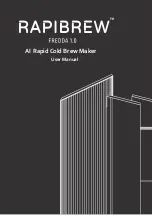
SKU 66786
for technical questions, please call 1-800-444-3353.
Page 9
fill level. When oil level reaches the
Hoop (14), drain the oil.
Back off Lock Knob (3) and raise
4.
Drain Tube to above Gate Valve “ball”
and tighten Lock Knob. Rotate Ball
Valve handle to horizontal position.
Place Nozzle (12) securely in a used
5.
oil collection receptacle.
WaRning!
Be sure to follow all local regulations
regarding proper used oil collection.
Connect the compressor’s air supply
6.
hose to the Air Inlet (9). Turn on the
air compressor, making sure it is set
between 7-10 PSI.
WaRning! do not leave oil lift
7.
unattended while it is in the evacu-
ating oil process.
Please note:
8.
The Oil Lift has a
Safety Valve (8) that can be pulled to
rapidly release pressure in the Tank
in case of an emergency.
Close Regulator (7) by pulling out the
9.
knob and rotating counterclockwise.
Pull Regulator’s cap out and slowly
turn it in a clockwise direction while
observing the Pressure Gauge.
do
not exceed 10 PSi.
Once oil is no longer being dis-
10.
charged from the Nozzle, turn off air
compressor. Disconnect compressor
air supply hose from the Air Inlet.
Before transporting the Oil Lift, open
11.
the Lock Knob (3) and lower all the
way. Then lock Drain Tube in place
by turning the Lock Knob.
Use the Handle (10) when moving
12.
the Oil Lift from one location to an-
other. Always grasp the Handle with
two hands and only transport Oil Lift
along flat, level surfaces able to with
-
stand the weight of the Oil Lift.
If the tool requires more force to
13.
accomplish the task, verify that the
tool receives sufficient, unobstructed
airflow (CFM) and increase the
pressure (PSI) output of the regulator
up to the maximum air pressure
rating of this tool.
cauTion! To PREVEnT Tool
and accESSoRY failuRE,
RESulTing in injuRY:
do not exceed the tool’s maximum
air pressure rating of 10 PSi.
Please note:
14.
Oil discharge rate will
be slightly affected by the outside
temperature.
uSER-mainTEnancE
inSTRucTionS
Procedures not specifically
explained in this manual
must be performed only by a
qualified technician.
To PREVEnT
SERiouS injuRY
fRom accidEnTal
oPERaTion: Turn off tool,
detach air supply, safely
discharge any residual air
pressure in tool before
performing any inspection,
maintenance, or cleaning.
To PREVEnT SERiouS
injuRY fRom Tool
failuRE: do not use
damaged equipment. if
abnormal noise, vibration, or
leaking air or oil occurs, have
the problem corrected before
further use.































